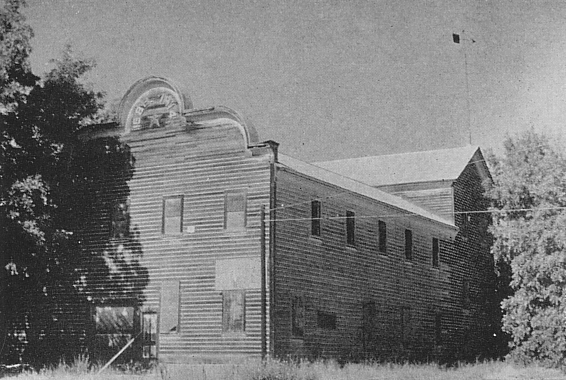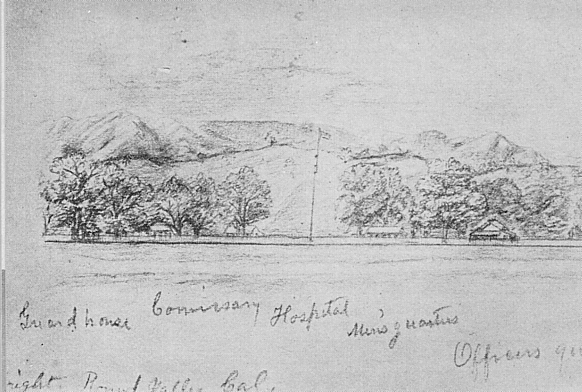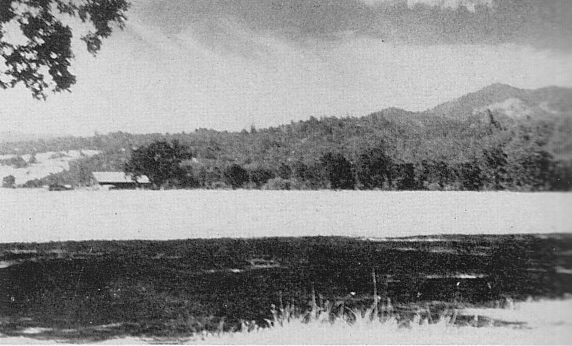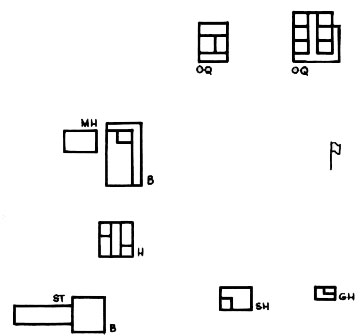


In response no urgent requests for much needed soldiers in Mendocino County made by George M. Hanson, Superintendent of Indian Affairs for northern California, troops were ordered to Round Valley on October 28, 1862. The unit chosen was Company F, 2nd California Volunteer Infantry Regiment, Captain Charles D. Douglas commanding, which was ordered from Fort Gaston to Round Valley via Fort Humboldt and Fort Bragg. After protracted delays enroute, the troops arrived at their destination on December 11, 1862. According to National Archives records, however, the post's first garrison consisted of seven companies of the 9th Infantry, under the command of Captain F. T. Dent. A site was selected, and the new post was named Fort Wright, designated Camp Wright after the Civil War, for General George Wright, commander of the Department of the Pacific.
The post was located about one and a half miles northwest of the present town of Covelo. One of the principal duties of the camp's troops was the protection of the area's Indians and their interests from the depredations of bigoted and thieving whites. During 1863 and 1864 construction on the post continued with the building of log structures roofed with shakes designed for two officers' quarters, barracks, mess hall, bakery, hospital, guardhouse, storehouse and stables. In 1869 construction was resumed and continued for several years, including the building of a new adobe company barracks in 1869 on the south side of the parade ground, the same year a military reservation one mile square was established. Finally, because of the permaneny of the friendly relations with the reservation Indians, the post was ordered abandoned on June 10, 1875 and the troops left a week later. On July 26, 1876, the buildings and military reservation were transferred to the Interior Department for use and occupancy by the reservation's indians, for whose benefit the land was later divided into 10-acre allotments.
The welfare of the Indian was at stake at this post in Round Valley, Mendocino county, when soldiers were dispatched there in 1862. The situation seemed not unlike that of 1858 when troops first camped in the valley, their mission to keep the Indians pacified-and safe from the self-appointed state volunteers who blazed a massacre trail through Northern California.
A detachment of the 6th U. S. Infantry watched over the valley's Nome Cult Agency until 1860, at the same time supervising the cattle herds grazing there from the coast forts. No sooner did the soldiers leave in September 1861, than rumors of Indian misdeeds filtered into headquarters.
In October 1862, it was reported that squatters were forcing the Indians from their reservation lands. A quarter of the 2,000 Indians in Round Valley supposedly fled after 22 alleged Indian rustlers were massacred by whites. The Agency Supervisor reported he was fired on twice while in bed.
Captain Charles D. Douglas and his Company F, 2d California Infantry, were ordered to the valley. This former garrison of abandoned Fort Anderson arrived in December 1862.
Douglas' first official act was to close the valley's only saloon. He was told that it was the "headquarters of the disloyal men of the valley, and to prevent trouble between my men and them just now I thought it was best to close the house," be reported. "The order was obeyed without a word."
Armed with a declaration of martial law, Douglas investigated the earlier reports. The results were not quite what he expected. Apparently the massacred Indians had been camping near the house of one of the Agency Supervisor's sons and everyone but the victims knew what was planned. One son lent his pistol for use in the massacre, and another son moved his family to his father's house "to prevent his wife from being frightened during the affray."
The settlers claimed that they killed the "wild and hostile band" in self defense to protect the peaceful occupants of the valley.
The matter of the supervisor being shot at by the settlers also had an explanation. The two shootings were not anonymous threats against the supervisor, Douglas found, but the work of two men who were unhappy: "because the supervisor took their squaws away from them."
Douglas' first report charged that the agency employees "were grossly neglecting their duties."
"I will here state that the mismanagement of Indian affairs in this valley has brought the Government into discredit, so much so that the settlers of the valley will not sell a pound of provisions without cash in hand," Douglas said. He added that one citizen pledged his personal bond so that the Indians could be given 2,500 bushels of corn to stave off starvation.
Charges followed charges in the next few months while Douglas did his best to protect the Indians and build quarters for his 70-man company. He said that the agent had no idea how many Indians were in his custody, but that this was not necessary because he did nothing for them anyway. The keys to the government storehouse were left with a squaw when the agent left on personal business, Douglas noted.
Every attempt by the Indians to better their lot was frustrated by the agent, Douglas explained. When they tried to build fences to protect crops from the settlers' wandering-and illegal-cattle, the Indians were assigned useless jobs elsewhere. "Utter neglect of duty" is how Douglas summed up the Indian Agency's performance at Round Valley.
Convinced that the fault lay with the agency rather than the Indians and the settlers, in February 1863, Douglas revoked martial law, except for the matter of selling liquor. For a while he tried to concentrate on building his post, naming it Fort Wright after the department commander without regard for possible confusion with the Oak Grove Camp Wright.
A murder four miles north of Round Valley in April 1863, took Douglas on one of the few patrols fielded by the garrison. He led 15 men out of the valley after dark, "to conceal my movements from the every watchful enemy," and marched a day through a driving snowstorm. Two stragglers from the pursued band of Indians were captured the first night and the main camp was located the next morning.
"I endeavored to make them all prisoners, but could not, as they would not surrender, but fight," Douglas reported. "I therefore gave the order to fire and the entire party were killed, except two, old squaws who gave themselves up. Six bucks were here killed, not one of the whole party getting away."
Douglas' methods were effective, but drastic, during the tour. He wasted no time when be learned that a barn burning in July 1863, was the first step in a plot by the Ukie tribe "to kill all the white men they could, burn their property, and then go into the mountains."
One patrol killed four or five Indians who were routing settlers from their homes. Two Indians, including the principal chief, were killed while trying to murder a settler. With the aid of testimony of both settlers and Indians, Douglas was able to identify the five leaders of the plot. In the presence of all Indians in the valley, the five were hung at the new Army post on July 21, 1863.
Douglas was convinced that his firm actions "will have a very good effect on the whole tribe," he explained. "It has already restored quiet among them."
The war with the agency continued, however. In September 1863, Douglas evicted the Agency Supervisor and appointed another in his place. Soon he was told by headquarters to keep out of Indian Bureau business and to concentrate on preventing escapes from the valley. He responded that the agent never reported any escapes, and he was unable to learn of any because of rules against the troopers visiting the agency.
In April 1864, the animosity between agency and Army hit a peak. District headquarters was told to replace the garrison at Fort Wright with another company. The shift was postponed upon the request of the district commander, and then cancelled when the Indian Superintendent for California visited Round Valley. The Agency was reorganized. On the superintendent's recommendation, the fort's garrison was enlarged with a company of California Native Cavalry.
Finally in a position to keep the peace without undue problems with the Supervising Agent, Douglas and his men stayed at Fort Wright until May 1866, when they were mustered out of service.
TO GET THERE: From Fort Bragg, California, go southeast on State 20 to U.S. 101 at Willits. Head north on U.S. 101 about 24 miles to Laytonville. Turn right (east) 12 miles to Del Rios,continue 16 more miles to Round Valley. Post was in northwest corner of valley.




| B | Barracks |
| COMM | Commissary |
| GH | Guardhouse |
| H | Hospital |
| MH | Mess Hall |
| OQ | Officers' Quarters |
| SH | Storehouse |
| ST | Stable |
"Erect buildings in such a matter as to afford shelter for the entire command in case of attack," founder of Fort Wright was ordered, "as, for instance, by connecting them together by a stockade work, which should be loopholed as well as the buildings." Keeping peace and providing detachments elsewhere left less than dozen men to work on post after doing other duties, but ultimately post took on this appearance. Most buildings were of logs, covered by clapboards, except for adobe barracks and one brick officers' quarters. (Redrawn from plat in Col. Fred Rogers collection.)
This page was reprinted with permission from Pioneer Forts of the Far West, published in 1965